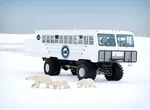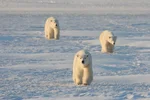A guide to polar bears, one of the world’s most-vulnerable species
One of the most fascinating species to observe in Northern Canada is the Polar Bear. There are approximately 25,000 polar bears living wild on Earth, with approximately 60 per cent of them found in Canada alone.
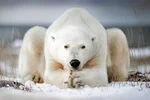
Polar bears are marvels of evolution. To be able to live in the cold arctic environment, they developed 4½ -inch thick layers of fat and huge padded feet. Their broad paddle-like forepaws act like snowshoes for walking on ice and snow, and work like oars when they swim. Polar bears rely heavily on their sense of smell for finding food and other bears. With their keen sense of smell, polar bears can detect prey from as far away as 20 miles, even through snow or ice that is six feet thick.
The travel experts at canadapolarbears.com can help you plan an unforgettable trip to Churchill, Manitoba for a guided polar-bear tour. As part of our personalized travel support from planning through travel, we take care of all the details. We book your wildlife tours, accommodations, and unique local experiences. You get to relax and enjoy making memories.
Popular polar-bear tours
Polar-bear populations
Polar bear populations fluctuate in response to natural factors such as climate and prey availability. Populations can also be impacted by humans through factors such as hunting, oil spills, shipping, and other activities. Advances in satellite telemetry and other advanced technology have helped researchers track polar bear patterns more definitively, which has greatly enhanced our knowledge of movements and population bounds.
Polar bears have long captured our attention, but probably at no time in the past have they been more in the forefront of the public's attention than today. The international organization, Polar Bears International, predicts that if current warming trends continue in the Arctic, two-thirds of the world's polar bears could disappear by 2050.
Today's heightened interest in polar bears may be due in part to an enhanced understanding of the current global warming at the polar ice caps, as well as polar bear ecology and the recent issues regarding whether they should be considered endangered. Recent efforts to communicate these concerns, research and statistics have been made to the public to help heighten the public awareness.
Results of years of research and studies are now available to an interested public, and efforts to communicate this information to the public have been more effective in recent years than in the past.
Polar-bear ecology
Polar bears are not a single large homogeneous population, but are rather comprised of groups referred to as stocks or populations, which are distributed throughout the Arctic. The first extensive research began in the late 1960s and has made significant progress today. We now have a thorough backdrop of information on population demographics, systematically analyzed data on population boundaries, population movements, population size, reproductive and survival parameters, and other useful information about biological, physiological, and ecological aspects of polar bears.
Research indicates that polar bears do not occur in large numbers. In addition, their ability to replace individuals in the population is very limited and population growth is extremely slow; however, they are long-lived creatures, which helps to offset the low reproductive potential.
Polar Bears in Summer
In summer, sea ice melts first along the heat-absorbing Alaskan coastline. Polar bears find cracks in the ice pack that are narrowly open or thinly frozen over, for hunting seals. Most bears in the Beaufort and Chukchi Seas stay on the main pack to hunt, as it recedes miles from shore. Bears distribute themselves along the ice edges, where they have better access to seals. Outside of the main ice pack, isolated ice floes break into smaller floes or large patches of unconsolidated ice. Bears that are isolated from the main pack or land use these floes like a series of floating islands for hunting or resting. Eventually the floes become too small for a bear, which may have to swim to the main ice pack or to land.
Polar bears in Autumn and Winter
As summer turns into fall, the Arctic begins to cool. During the onset of the long dark winter, virtually all of the Arctic Ocean refreezes. In fall, ice and bears return nearer to shore. As autumn progresses, temperatures cool, and ice begins to form again. Polar bears follow that leading edge of ice south, eventually occupying the shallow waters of the continental shelf, where the seal population is highest. To adapt, polar bears build fat stores necessary for winter survival. Pregnant females particularly fatten in early autumn to fuel their long winter fast and the nursing of their cubs. Later in autumn, they look for winter birthing dens near the coast or on stable ice pack, near good hunting habitat. Long swims between sea ice and shore deplete their body stores, affecting their reproductive success.
Take advantage of gear rental
Don't worry about buying boots and jackets suitable for arctic temperatures. Winter clothing rentals are available, and will also save space in your suitcase.

Global warming and polar bears
The Arctic ecosystem is heavily vulnerable to climate change. With the increasing warming occurring at the polar ice caps, many species are being affected. Polar bears serve as key indicators of this as their populations are being reduced significantly in recent years. Today, polar bear populations are facing threats previously unprecedented during recorded history in the Arctic. According to the World Wildlife Organization, recent climate change scenarios based upon aggregate climate trend data predict that the Arctic region will experience major changes in the upcoming decades. To get an idea, the Arctic basin's ice thickness has already decreased by 40% over the past 30 years. The average annual extent of ice coverage in the polar region has also diminished substantially, with an average annual reduction of over 1 million square kilometers.
See the polar bears in the wild
With ecological impacts facing the arctic polar bears, it's necessary that we warrant their future protection. If you've ever dreamed of experiencing polar bears close-up or would like to learn about them in their own environment, Cape Churchill, Manitoba, Canada is known as the "polar bear capital of the world." In October and early November, polar bears gather at Cape Churchill and wait for ice to form on the Hudson Bay. If you're interested in discovering these magnificent creatures up close, then check out our Canada vacation packages so you can gain the polar bear experience of a lifetime.
Churchill, Manitoba is located on the southern shores of the Hudson Bay, where over a thousand polar bears arrive each year in late October where they rest, play and wait for the Bay to freeze so they can continue their annual migration. It's unlike anything you've ever experienced; only in Churchill, MB can you see polar bears in these numbers all in one place.
You'll probably want to jump in the nearest tundra buggy and start your polar bear watching the second you arrive; but there are a few things you should see and do in Churchill, MB including an Inuit art museum, the natural history exhibits of the Parks Canada Centre and if the snows have started to arrive, a ride on a dog sled is not to be missed. Don't forget to look up either! Manitoba's Hudson Bay region is home to many species of waterfowl and other birds and on a clear night, you'll be able to see the Northern Lights! It's just the right finishing touch on a perfect Canadian vacation.
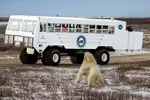
Why book your trip with Fresh Tracks Canada?
Unforgettable Canadian vacations made just for you
Enjoy local expertise and guidance with a fully planned itinerary. Personalize your trip by adding extra time in Canada at the start or end of your Northern Lights tour.
We take care of all the details
Relax and focus on making memories. Let us make all of the bookings for you, including your guided polar-bear tour, hotels, excursions and activities, and transfers.
Support when you need it
We’re here to make sure you get the inside scoop before you even leave home. And you can relax on your vacation because you know that we’re a phone call away if you have any questions while you’re in Canada.
What Our Customers Say
Discover more about polar bears
Discuss your polar-bear tour with a Canadian travel expert
Or call us toll free
1 877 395 5671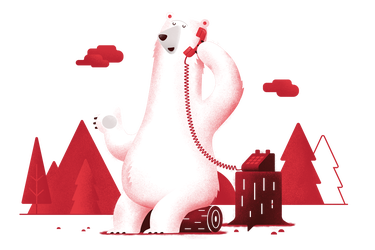
Sign up for travel inspiration
Our newsletter is full of local tips and insights for an unforgettable Canadian vacation.
By submitting this form, you agree to our collection and use of your personal data as outlined in our Privacy Policy. We’ll use your information to process your request, improve our services, and share trip planning ideas, travel inspiration, and exclusive offers. You can unsubscribe at any time using the link in every email. We do not share your data without consent, except as required by law. Phone numbers will not be used for SMS.
Popular Trips
Lords of the Wilderness Bear ViewingSubarctic Discovery: Churchill Polar BearsClassic Churchill Polar Bears Tundra Buggy Lodge Polar Bear ViewingCanadian Train and Polar Bear AdventureChurchill Belugas and Bears Summer AdventureExplore Canada Polar Bears
Polar-Bear Tours in Churchill Tundra-Buggy Polar-Bear ToursBest Grizzly and Polar-Bear Tours Polar-Bear Tours in SummerBest Time to See Polar Bears in ChurchillFacts About Canadian Polar BearsArctic Wildlife in ChurchillFacts About Beluga Whales in ChurchillPolar-Bears Tours on Hudson BayArctic Tours in CanadaThis site is protected by reCAPTCHA and the Google Privacy Policy and Terms of Service apply.
![Dave and Jill review of their [object Object] trip](https://cdn.bfldr.com/UAHFH8T4/as/5ttwk3xk64xbqb4644ms2m/Dave_Jill_382?auto=webp&format=webp&width=75)
![Charlie and Carol Ann review of their [object Object] trip](https://cdn.bfldr.com/UAHFH8T4/as/m39xrxszj4vnq7jshws4hh8s/Charlie_Carol_Ann_379?auto=webp&format=webp&width=75)
